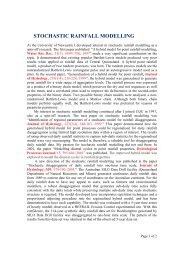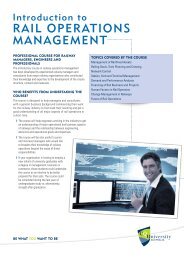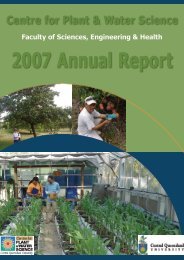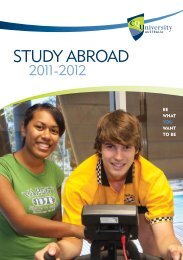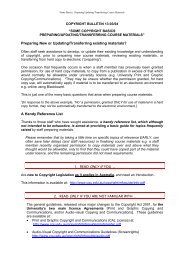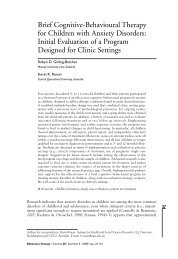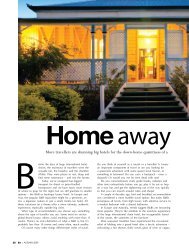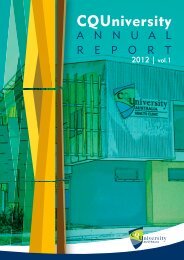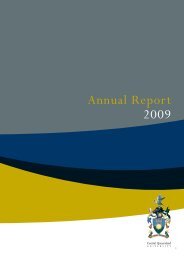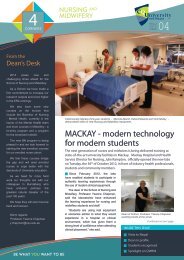Physical activity trends in Queensland - Wiley Online Library
Physical activity trends in Queensland - Wiley Online Library
Physical activity trends in Queensland - Wiley Online Library
- No tags were found...
You also want an ePaper? Increase the reach of your titles
YUMPU automatically turns print PDFs into web optimized ePapers that Google loves.
<strong>Physical</strong> <strong>activity</strong><strong>Physical</strong> <strong>activity</strong> <strong>trends</strong> <strong>in</strong> <strong>Queensland</strong>possible that, <strong>in</strong> relation to deliver<strong>in</strong>g health <strong>in</strong>formation, men are alot harder to reach as compared to women; this might be illustratedby the fact that women <strong>in</strong> many <strong>in</strong>tervention trials have largelyoutnumbered men. 29 The gender differences <strong>in</strong> physical <strong>activity</strong><strong>trends</strong> observed <strong>in</strong> this study <strong>in</strong>dicate that it might be needed totarget men and women differently <strong>in</strong> health promotion messages.Further research should <strong>in</strong>dicate whether it is needed to re-evaluatehealth promotion practices and messages aimed at men.No shifts <strong>in</strong> the proportions of different <strong>activity</strong> types wereobserved over time (Figure 1), hence the trend of <strong>in</strong>creas<strong>in</strong>gphysical <strong>activity</strong> was equal across different types of physical<strong>activity</strong>. This was contrary to what Merom et al. and Chau et al.reported, who observed that an <strong>in</strong>crease <strong>in</strong> total physical <strong>activity</strong>was ma<strong>in</strong>ly due to an <strong>in</strong>crease <strong>in</strong> walk<strong>in</strong>g. 10,12 However, anotherobservation by Merom et al. was similar to a f<strong>in</strong>d<strong>in</strong>g of thisstudy: a decreas<strong>in</strong>g trend <strong>in</strong> the participants who only walk andan <strong>in</strong>creas<strong>in</strong>g trend for participants who walk <strong>in</strong> comb<strong>in</strong>ation withother activities (Table 2). 12 Figure 1 further illustrates that walk<strong>in</strong>g,which has been shown to be amendable to change even amongthe least active socio-demographic groups, 21 has the potential toreduce disparities <strong>in</strong> physical <strong>activity</strong>, which has been argued byother several <strong>in</strong>vestigators as well. 12,30,31 Not only does it show thatwalk<strong>in</strong>g is the most important form of <strong>activity</strong> for all demographicsubgroups, it is even more so for women, older people, peoplewith a low education or low <strong>in</strong>come and high BMI. These f<strong>in</strong>d<strong>in</strong>gsare <strong>in</strong> l<strong>in</strong>e with observations <strong>in</strong> other studies, as are the higherproportions of vigorous physical <strong>activity</strong> seen <strong>in</strong> men, younger, ofnormal weight, of higher <strong>in</strong>come, of higher education and regionaltown participants. 31,32It could be argued that people with a lower education might havehad a lower exposure to the physical <strong>activity</strong> messages <strong>in</strong> the pastand are now catch<strong>in</strong>g up, 33 which might expla<strong>in</strong> why the significant<strong>in</strong>creas<strong>in</strong>g trend <strong>in</strong> achiev<strong>in</strong>g sufficient <strong>activity</strong> levels was seen <strong>in</strong>people with a lower education only. Similar outcomes have beenobserved <strong>in</strong> knowledge related physical <strong>activity</strong> <strong>in</strong>terventions thatwere more effective for lower educated participants as comparedto higher educated participants. 34,35 Decreas<strong>in</strong>g physical <strong>activity</strong>levels have commonly been associated with <strong>in</strong>creas<strong>in</strong>g BMIlevels, 25,36 however this does not expla<strong>in</strong> why an <strong>in</strong>creas<strong>in</strong>g trendfor physical <strong>activity</strong> was only seen <strong>in</strong> people with a normalweight and not <strong>in</strong> overweight or obese participants. It is also notcomparable with data from New South Wales where the physical<strong>activity</strong> <strong>trends</strong> across BMI groups were more or less equal. 7,10,12Although other studies often report more sufficient physical<strong>activity</strong> <strong>in</strong> more urbanised populations, 37-39 this was not confirmed<strong>in</strong> this study or <strong>in</strong> other <strong>Queensland</strong> studies, 40 where equal levelsof physical <strong>activity</strong> were observed for both regional town and ruralparticipants. The most likely explanation is that participants liv<strong>in</strong>g<strong>in</strong> a ‘regional town’ <strong>in</strong> Australia are not urbanised enough to makethe difference with rural participants apparent.The strengths of this study are the large number of participantsand the use of a common research protocol across all waves ofdata collection. This has produced consistent outcomes, whichare comparable for each survey year. On the other hand, socialdesirability may have <strong>in</strong>duced over-report<strong>in</strong>g when us<strong>in</strong>g selfreport<strong>in</strong>gCATI measures. However, although over-report<strong>in</strong>gmay have been present, social desirability can not expla<strong>in</strong> theobserved <strong>in</strong>creas<strong>in</strong>g <strong>trends</strong> <strong>in</strong> physical <strong>activity</strong>, as it will have beena confounder equally present at all assessment po<strong>in</strong>ts. Further,participants were contacted via land l<strong>in</strong>es only, not mobile phones;hence the group of younger participants might not have beenentirely representative, as more and more young people are nolonger contactable us<strong>in</strong>g conventional land l<strong>in</strong>es. 41 F<strong>in</strong>ally, ActiveAustralia Survey protocols do not allow to determ<strong>in</strong>e wether them<strong>in</strong>imum of five <strong>activity</strong> sessions (which are needed <strong>in</strong> order tobe ‘sufficiently active’) were performed on five separate days orless; 8 this is a methodological limitation as the Australian <strong>activity</strong>guidel<strong>in</strong>es state that the m<strong>in</strong>imum level of <strong>activity</strong> should beachieved on at least five separate days. 5In conclusion, although an <strong>in</strong>creas<strong>in</strong>g trend for sufficientphysical <strong>activity</strong> was observed, overall physical <strong>activity</strong> levels<strong>in</strong> Central <strong>Queensland</strong> rema<strong>in</strong> low and more efforts to <strong>in</strong>creasephysical <strong>activity</strong> are needed. The gender differences <strong>in</strong> physical<strong>activity</strong> <strong>trends</strong> <strong>in</strong>dicate that it might be needed to target men andwomen differently <strong>in</strong> health promotion messages. Rigorous andcont<strong>in</strong>uous monitor<strong>in</strong>g of population levels of physical <strong>activity</strong><strong>in</strong> Australia, which allow both state specific and <strong>in</strong>ternationalcomparisons, is needed. This will provide a stronger rationale andmore guidance (what works and what does not) for Commonwealthand State Governments as they attempt to create or ma<strong>in</strong>ta<strong>in</strong> goodhealth for all Australians.AcknowledgementsVandelanotte is supported by a National Health and MedicalResearch Council of Australia (#519778) and National HeartFoundation of Australia (#PH 07B 3303) post-doctoral researchfellowship. The Central <strong>Queensland</strong> Social Survey is funded by theInstitute for Health and Social Science Research and conducted bythe Population Research Laboratory at CQ University Australia.References1. Pate RR, Pratt M, Blair SN, Haskell WL, et al. <strong>Physical</strong>-Activity andPublic-Health − a Recommendation from the Centers-for-Disease-Controland-Preventionand the American-College-of-Sports-Medic<strong>in</strong>e. JAMA.1995;273(5):402-7.2. US Department of Health and Human Services. <strong>Physical</strong> Activity and Health.A report of the Surgeon General. Atlanta (GA): Centres for Disease Controland Prevention, National Centre for Chronic Disease Prevention and HealthPromotion; 1996.3. Mathers CD, Vos ET, Stevenson CE, Begg SJ. The burden of disease and <strong>in</strong>jury<strong>in</strong> Australia. Bull World Health Organ. 2001;79(11):1076-84.4. Stephenson J, Bauman A, Amstrong T, Smith B, et al. The Cost of IllnessAttributable to <strong>Physical</strong> In<strong>activity</strong>. Canberra (AUST): CommonwealthDepartment of Health and Aged Care; 2000.5. Department of Health and Age<strong>in</strong>g. National <strong>Physical</strong> Activity Guidel<strong>in</strong>es forAustralians. Canberra (AUST): Commonwealth of Australia; 1999.6. Macera CA, Pratt M. Public health surveillance of physical <strong>activity</strong>. Res QExerc Sport. 2000;71 Suppl 2:97-103.7. Merom D, Phongsavan P, Chey T, Bauman A. Long-term changes <strong>in</strong> leisuretime walk<strong>in</strong>g, moderate and vigorous exercise: Were they <strong>in</strong>fluenced by thenational physical <strong>activity</strong> guidel<strong>in</strong>es? J Sci Med Sport. 2006;9(3):199-208.8. Australian Institute of Health and Welfare. The Active Australia Survey: A Guideand Manual for Implementation, Analysis and Report<strong>in</strong>g. Canberra (AUST):AIWH; 2003.2010 vol. 34 no. 3 AUSTRALIAN AND NEW ZEALAND JOURNAL OF PUBLIC HEALTH 253© 2010 The Authors. Journal Compilation © 2010 Public Health Association of Australia
Vandelanotte et al.Article9. Bauman A, Armstrong T, Davies J, Owen N, et al. Trends <strong>in</strong> physical <strong>activity</strong>participation and the impact of <strong>in</strong>tegrated campaigns among Australian adults,1997-99. Aust NZ J Public Health. 2003;27(1):76-9.10. Chau J, Smith BJ, Bauman A, Merom D, et al. Recent <strong>trends</strong> <strong>in</strong> physical <strong>activity</strong><strong>in</strong> New South Wales. Is the tide of <strong>in</strong><strong>activity</strong> turn<strong>in</strong>g? Aust NZ J Public Health.2008;32(1):82-5.11. Armstrong T, Bauman A, Davis J. <strong>Physical</strong> Activity Patterns of AustralianAdults. Results of the 1999 National <strong>Physical</strong> Activity Survey Canberra (AUST):Australian Institute of Health and Welfare; 2000.12. Merom D, Chey T, Chau J, Smith BJ, et al. Are messages about lifestyle walk<strong>in</strong>gbe<strong>in</strong>g heard? Trends <strong>in</strong> walk<strong>in</strong>g for all purposes <strong>in</strong> New South Wales (NSW),Australia. Prev Med. 2009;48(4):341-4.13. Bauman A, Ford I, Armstrong T. Trends <strong>in</strong> population levels of reported physical<strong>activity</strong> <strong>in</strong> Australia, 1997, 1999 and 2000. Canberra (AUST): Australian SportsCommission; 2001.14. <strong>Queensland</strong> Health. The Health of <strong>Queensland</strong>ers 2008: Prevention of ChronicDisease. 2nd report of the Chief Health Officer <strong>Queensland</strong>. Brisbane (AUST):State Government of <strong>Queensland</strong>; 2008.15. Brown WJ, Trost SG, Bauman A, Mummery K, et al. Test-retest reliability offour physical <strong>activity</strong> measures used <strong>in</strong> population surveys. J Sci Med Sport.2004;7(2):205-15.16. Brown W, Bauman A, Chey T, Trost S, et al. Comparison of surveys used tomeasure physical <strong>activity</strong>. Aust NZ J Public Health. 2004;28(2):128-34.17. Australian Bureau of Statistics. 2006 Census of Population and Hous<strong>in</strong>g,<strong>Queensland</strong>. Canberra (AUST): ABS; 2006. Catalogue No.: 2068.0.18. Rural and Regional Health and Aged Care Services. Victorian Public HealthService 2006. Melbourne (AUST): Victorian Department of Human Services;2007.19. Bruce MJ, Katzmarzyk PT. Canadian population <strong>trends</strong> <strong>in</strong> leisure-time physical<strong>activity</strong> levels, 1981-1998. Can J Appl Physiol. 2002;27(6):681-90.20. DuBose KD, Kirtland KA, Hooker SP, Fields RM. <strong>Physical</strong> <strong>activity</strong> <strong>trends</strong> <strong>in</strong>South Carol<strong>in</strong>a, 1994-2000. South Med J. 2004;97(9):806-10.21. Simpson ME, Serdula M, Galuska DA, Gillespie C, et al. Walk<strong>in</strong>g <strong>trends</strong> amongU.S. adults: The Behavioral Risk Factor Surveillance System, 1987-2000. AmJ Prev Med. 2003;25(2):95-100.22. Helkapori S, Uutela A, Prattala R, Pusk, P. Heath Behaviour and Health amongthe F<strong>in</strong>nish Population. Hels<strong>in</strong>ki (FIN): National Public Health Institute;2000.23. Norman A, Bellocco R, Vaida F, Wolk A. Age and temporal <strong>trends</strong> of totalphysical <strong>activity</strong> <strong>in</strong> Swedish men. Med Sci Sports Exerc. 2003;35(4):617-22.24. Ors<strong>in</strong>i N, Bellocco R, Bottai M, Pagano M, et al. Age and temporal <strong>trends</strong>of total physical <strong>activity</strong> among Swedish women. Med Sci Sports Exerc.2006;38(2):240-5.25. Gast GCM, Frenken FJM, Van Leest LATM, Wendel-Vos GCW, et al. Intranationalvariation <strong>in</strong> <strong>trends</strong> <strong>in</strong> overweight and leisure time physical activities<strong>in</strong> The Netherlands s<strong>in</strong>ce 1980: Stratification accord<strong>in</strong>g to sex, age andurbanisation degree. Int J Obes. 2007;31(3):515-20.26. Roman-V<strong>in</strong>as B, Serra-Majem L, Ribas-Barba L, Roure-Cusp<strong>in</strong>era E, et al.Trends <strong>in</strong> physical <strong>activity</strong> status <strong>in</strong> Catalonia, Spa<strong>in</strong> (1992-2003). Public HealthNutr. 2007;10(11 A):1389-95.27. Mummery WK, Schofield G, H<strong>in</strong>chliffe A, Joyner K, Brown W. Dissem<strong>in</strong>ationof a community-based physical <strong>activity</strong> project: The case of 10,000 steps. J SciMed Sport. 2006;9(5):424-30.28. Brown w, Mummery K, Eak<strong>in</strong> EG, Schofield G. 10,000 Steps Rockhampton:Evaluation of a Whole Community Approach to Improv<strong>in</strong>g Population Levelsof <strong>Physical</strong> Activity. J Phys Act Health. 2006;1:1-14.29. Vandelanotte C, De Bourdeaudhuij I, Sallis JF, Spittaels H, Brug J. Efficacyof sequential or simultaneous <strong>in</strong>teractive computer-tailored <strong>in</strong>terventionsfor <strong>in</strong>creas<strong>in</strong>g physical <strong>activity</strong> and decreas<strong>in</strong>g fat <strong>in</strong>take. Ann Behav Med.2005;29(2):138-46.30. Lee IM, Buchner DM. The importance of walk<strong>in</strong>g to public health. Med SciSports Exerc. 2008;40 Suppl 7:512-8.31. Cole R, Leslie E, Bauman A, Donald M, et al. Socio-Demographic Variations <strong>in</strong>Walk<strong>in</strong>g for Transport and for Recreation or Exercise Among Adult Australians.J Phys Act Health. 2006;3:164-78.32. Trost SG, Owen N, Bauman AE, Sallis JF, et al. Correlates of adults’participation <strong>in</strong> physical <strong>activity</strong>: review and update. Med Sci Sports Exerc.2002;34(12):1996-2001.33. Sallis J, Owen N. <strong>Physical</strong> Activity and Behavioral Medic<strong>in</strong>e. Thousand Oaks(CA): Sage; 1999.34. Vandelanotte C, Reeves MM, Brug J, De Bourdeaudhuij I. A randomized trialof sequential and simultaneous multiple behavior change <strong>in</strong>terventions forphysical <strong>activity</strong> and fat <strong>in</strong>take. Prev Med. 2008;46(3):232-7.35. Brug J, van Assema P. Differences <strong>in</strong> use and impact of computer-tailoreddietary fat-feedback accord<strong>in</strong>g to stage of change and education. Appetite.2000;34(3):285-93.36. Hemm<strong>in</strong>gsson E, Ekelund U. Is the association between physical <strong>activity</strong> andbody mass <strong>in</strong>dex obesity dependent. Int J Obes. 2007;31:663-8.37. Parks SE, Houseman RA, Brownson RC. Differential correlates of physical<strong>activity</strong> <strong>in</strong> urban and rural areas of various socioeconomic backgrounds <strong>in</strong> theUnited States. J Epidemiol Community Health. 2003;57(1):29.38. Mart<strong>in</strong> SL, Kirkner GJ, Mayo K, Matthews CE, et al. Urban, rural, and regionalvariations <strong>in</strong> physical <strong>activity</strong>. J Rural Health. 2005;21(3):239-44.39. Eaton CB, Nafziger AN, Strogatz DS, Pearson TA. Self-reported physical<strong>activity</strong> <strong>in</strong> a rural county: A New York county health census. Am J PublicHealth. 1994;84(1):29-32.40. Duncan MJ, Mummery WK, Steele RM, Caperchione C, et al. Geographiclocation, physical <strong>activity</strong> and perceptions of the environment <strong>in</strong> <strong>Queensland</strong>adults. Health Place. 2009;15(1):204-9.41. Blumberg SJ, Luke JV, Cynamon ML. Telephone coverage and health surveyestimates: Evaluat<strong>in</strong>g the need for concern about wireless substitution. Am JPublic Health. 2006;96(5):926-31.254 AUSTRALIAN AND NEW ZEALAND JOURNAL OF PUBLIC HEALTH 2010 vol. 34 no. 3© 2010 The Authors. Journal Compilation © 2010 Public Health Association of Australia





